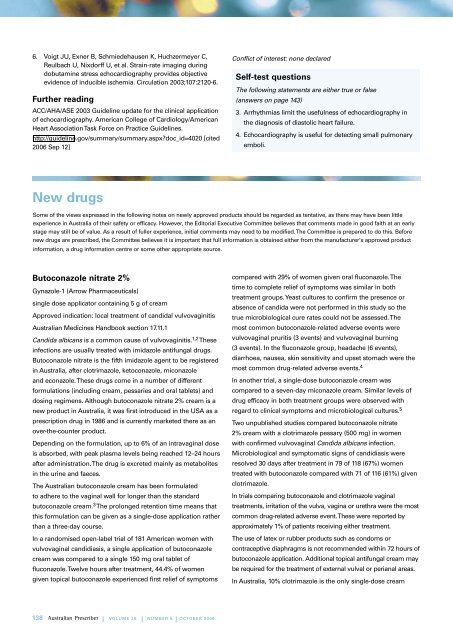download the full PDF issue - Australian Prescriber
download the full PDF issue - Australian Prescriber
download the full PDF issue - Australian Prescriber
You also want an ePaper? Increase the reach of your titles
YUMPU automatically turns print PDFs into web optimized ePapers that Google loves.
6. Voigt JU, Exner B, Schmiedehausen K, Huchzermeyer C,<br />
Reulbach U, Nixdorff U, et al. Strain-rate imaging during<br />
dobutamine stress echocardiography provides objective<br />
evidence of inducible ischemia. Circulation 2003;107:2120-6.<br />
Fur<strong>the</strong>r reading<br />
ACC/AHA/ASE 2003 Guideline update for <strong>the</strong> clinical application<br />
of echocardiography. American College of Cardiology/American<br />
Heart Association Task Force on Practice Guidelines.<br />
http://guideline.gov/summary/summary.aspx?doc_id=4020 [cited<br />
2006 Sep 12]<br />
New drugs<br />
138 | VOLUME 29 | NUMBER 5 | OCTOBER 2006<br />
Conflict of interest: none declared<br />
Self-test questions<br />
The following statements are ei<strong>the</strong>r true or false<br />
(answers on page 143)<br />
3. Arrhythmias limit <strong>the</strong> usefulness of echocardiography in<br />
<strong>the</strong> diagnosis of diastolic heart failure.<br />
4. Echocardiography is useful for detecting small pulmonary<br />
emboli.<br />
Some of <strong>the</strong> views expressed in <strong>the</strong> following notes on newly approved products should be regarded as tentative, as <strong>the</strong>re may have been little<br />
experience in Australia of <strong>the</strong>ir safety or efficacy. However, <strong>the</strong> Editorial Executive Committee believes that comments made in good faith at an early<br />
stage may still be of value. As a result of <strong>full</strong>er experience, initial comments may need to be modified. The Committee is prepared to do this. Before<br />
new drugs are prescribed, <strong>the</strong> Committee believes it is important that <strong>full</strong> information is obtained ei<strong>the</strong>r from <strong>the</strong> manufacturer's approved product<br />
information, a drug information centre or some o<strong>the</strong>r appropriate source.<br />
Butoconazole nitrate 2%<br />
Gynazole-1 (Arrow Pharmaceuticals)<br />
single dose applicator containing 5 g of cream<br />
Approved indication: local treatment of candidal vulvovaginitis<br />
<strong>Australian</strong> Medicines Handbook section 17.11.1<br />
Candida albicans is a common cause of vulvovaginitis. 1,2 These<br />
infections are usually treated with imidazole antifungal drugs.<br />
Butoconazole nitrate is <strong>the</strong> fifth imidazole agent to be registered<br />
in Australia, after clotrimazole, ketoconazole, miconazole<br />
and econazole. These drugs come in a number of different<br />
formulations (including cream, pessaries and oral tablets) and<br />
dosing regimens. Although butoconazole nitrate 2% cream is a<br />
new product in Australia, it was first introduced in <strong>the</strong> USA as a<br />
prescription drug in 1986 and is currently marketed <strong>the</strong>re as an<br />
over-<strong>the</strong>-counter product.<br />
Depending on <strong>the</strong> formulation, up to 6% of an intravaginal dose<br />
is absorbed, with peak plasma levels being reached 12–24 hours<br />
after administration. The drug is excreted mainly as metabolites<br />
in <strong>the</strong> urine and faeces.<br />
The <strong>Australian</strong> butoconazole cream has been formulated<br />
to adhere to <strong>the</strong> vaginal wall for longer than <strong>the</strong> standard<br />
butoconazole cream. 3 The prolonged retention time means that<br />
this formulation can be given as a single-dose application ra<strong>the</strong>r<br />
than a three-day course.<br />
In a randomised open-label trial of 181 American women with<br />
vulvovaginal candidiasis, a single application of butoconazole<br />
cream was compared to a single 150 mg oral tablet of<br />
fluconazole. Twelve hours after treatment, 44.4% of women<br />
given topical butoconazole experienced first relief of symptoms<br />
compared with 29% of women given oral fluconazole. The<br />
time to complete relief of symptoms was similar in both<br />
treatment groups. Yeast cultures to confirm <strong>the</strong> presence or<br />
absence of candida were not performed in this study so <strong>the</strong><br />
true microbiological cure rates could not be assessed. The<br />
most common butoconazole-related adverse events were<br />
vulvovaginal pruritis (3 events) and vulvovaginal burning<br />
(3 events). In <strong>the</strong> fluconazole group, headache (6 events),<br />
diarrhoea, nausea, skin sensitivity and upset stomach were <strong>the</strong><br />
most common drug-related adverse events. 4<br />
In ano<strong>the</strong>r trial, a single-dose butoconazole cream was<br />
compared to a seven-day miconazole cream. Similar levels of<br />
drug efficacy in both treatment groups were observed with<br />
regard to clinical symptoms and microbiological cultures. 5<br />
Two unpublished studies compared butoconazole nitrate<br />
2% cream with a clotrimazole pessary (500 mg) in women<br />
with confirmed vulvovaginal Candida albicans infection.<br />
Microbiological and symptomatic signs of candidiasis were<br />
resolved 30 days after treatment in 79 of 118 (67%) women<br />
treated with butoconazole compared with 71 of 116 (61%) given<br />
clotrimazole.<br />
In trials comparing butoconazole and clotrimazole vaginal<br />
treatments, irritation of <strong>the</strong> vulva, vagina or urethra were <strong>the</strong> most<br />
common drug-related adverse event. These were reported by<br />
approximately 1% of patients receiving ei<strong>the</strong>r treatment.<br />
The use of latex or rubber products such as condoms or<br />
contraceptive diaphragms is not recommended within 72 hours of<br />
butoconazole application. Additional topical antifungal cream may<br />
be required for <strong>the</strong> treatment of external vulval or perianal areas.<br />
In Australia, 10% clotrimazole is <strong>the</strong> only single-dose cream

















